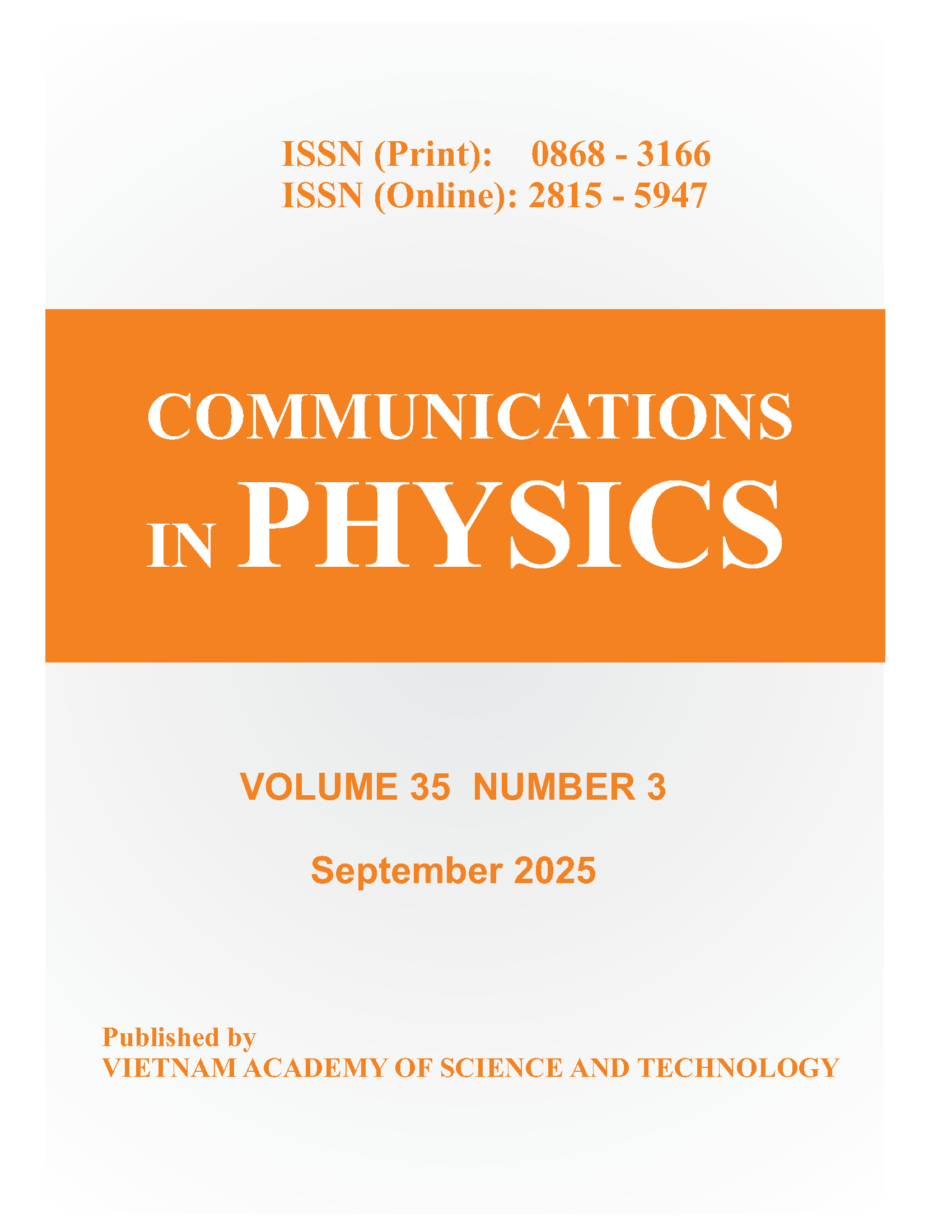Effects of Macromolecular Crowding on Folding of Small Globular Proteins
Author affiliations
DOI:
https://doi.org/10.15625/0868-3166/16830Keywords:
MD simulation, folding stability, scaled particle theoryAbstract
The effects of inert spherical crowders on the melting temperature and the folding stability of small globular proteins are investigated by using molecular dynamics simulations with a Gō-like model for the proteins. The energy parameter in the Gō-like model is obtained individually for each protein by matching the model’s melting temperature to the experimental melting
temperature in the absence of crowders. It is shown that both the melting temperature and the folding stability of protein increase in the presence of the crowders. Specifically, as the crowders’ volume fraction φc increases from 0 to 0.4 the melting temperature increases by more than 20 Kelvins, whereas the folding stability is enhanced by up to ∼3.6 kcal/mol depending on the protein and the temperature. At room temperature (300 K), the stability enhancement is 1.2–1.4 kcal/mol, which is close to prior experimental data. It is also shown that the dependence of the folding free energy change on φc can be fitted well to the scaled particle theory by assuming a linear dependence of the effective size of the unfolded state on φc .
Downloads
References
A. P. Minton, The effect of volume occupancy upon the thermodynamic activity of proteins: some biochemical consequences, Mol. Cell. Biochem. 55 (1983) 119.
S. B. Zimmerman and A. P. Minton, Macromolecular crowding: biochemical, biophysical, and physiological consequences, Ann. Rev. Biophys. Biomol. Struct. 22 (1993) 27.
H.-X. Zhou, G. Rivas and A. P. Minton, Macromolecular crowding and confinement: biochemical, biophysical, and potential physiological consequences, Annu. Rev. Biophys. 37 (2008) 375.
M. S. Cheung, D. Klimov and D. Thirumalai, Molecular crowding enhances native state stability and refolding rates of globular proteins, Proc. Natl. Acad. Sci. USA 102 (2005) 4753.
L. Stagg, S.-Q. Zhang, M. S. Cheung and P. Wittung-Stafshede, Molecular crowding enhances native structure and stability of a/b protein flavodoxin, Proc. Natl. Acad. Sci. USA 104 (2007) 18976.
B. van den Berg, R. J. Ellis and C. M. Dobson, Effects of macromolecular crowding on protein folding and aggregation, EMBO J. 18 (1999) 6927.
I. Horvath, R. Kumar and P. Wittung-Stafshede, Macromolecular crowding modulates a-synuclein amyloid fiber growth, Biophys. J. 120 (2021) 3374.
A. P. Minton, Effect of a concentrated inert macromolecular cosolute on the stability of a globular protein with respect to denaturation by heat and by chaotropes: a statistical-thermodynamic model, Biophys. J. 78 (2000) 101.
A. P. Minton, Models for excluded volume interaction between an unfolded protein and rigid macromolecular cosolutes: macromolecular crowding and protein stability revisited, Biophys. J. 88 (2005) 971.
H.-X. Zhou, Protein folding in confined and crowded environments, Arch. Biochem. Biophys. 469 (2008) 76.
A. H. Elcock, Models of macromolecular crowding effects and the need for quantitative comparisons with experiment, Curr. Opin. Struct. Bio. 20 (2010) 196.
J. Mittal and R. B. Best, Dependence of protein folding stability and dynamics on the density and composition of macromolecular crowders, Biophys. J. 98 (2010) 315.
D. S. Spencer, K. Xu, T. M. Logan and H.-X. Zhou, Effects of ph, salt, and macromolecular crowding on the stability of fk506-binding protein: an integrated experimental and theoretical study, J. Mol. Biol. 351 (2005) 219.
A. Roberts and S. E. Jackson, Destabilised mutants of ubiquitin gain equal stability in crowded solutions, Biophys. Chem. 128 (2007) 140.
P. T. Bui and T. X. Hoang, Additive effects of macromolecular crowding and confinement on protein stability, Comm. in Phys. 28 (2018) 351.
C. Clementi, H. Nymeyer and J. N. Onuchic, Topological and energetic factors: what determines the structural details of the transition state ensemble and en-route intermediates for protein folding? an investigation for small globular proteins1, J. Mol. Biol. 298 (2000) 937.
H. Taketomi, Y. Ueda and N. G, Studies on protein folding, unfolding and fluctuations by computer simulation, Int. J. Pep. Protein Res. 7 (1975) 445.
P. T. Bui and T. X. Hoang, Hydrophobic and electrostatic interactions modulate protein escape at the ribosomal
exit tunnel, Biophys. J. 120 (2021) 4798.
Y.-J. Chen, S.-C. Lin, S.-R. Tzeng, H. V. Patel, P.-C. Lyu and J.-W. Cheng, Stability and folding of the sh3 domain of bruton’s tyrosine kinase, Proteins: Struct. Funct. Bioinf. 26 (1996) 465.
J. W. Brown, J. D. Farelli and C. J. McKnight, On the unyielding hydrophobic core of villin headpiece, Prot. Sci. 21 (2012) 647.
P. T. Bui and T. X. Hoang, Protein escape at the ribosomal exit tunnel: Effects of native interactions, tunnel length, and macromolecular crowding, J. Chem. Phys. 149 (2018) 045102.
P. T. Bui and T. X. Hoang, Folding and escape of nascent proteins at ribosomal exit tunnel, J. Chem. Phys. 144 (2016) 095102.
Y. Sugita and Y. Okamoto, Replica-exchange molecular dynamics method for protein folding, Chem. Phys. Lett. 314 (1999) 141.
R. H. Swendsen and J.-S. Wang, Replica monte carlo simulation of spin-glasses, Phys. Rev. Lett. 57 (1986) 2607.
A. M. Ferrenberg and R. H. Swendsen, Optimized monte carlo data analysis, Phys. Rev. Lett. 63 (1989) 1195.
J. Lebowitz and J. Rowlinson, Thermodynamic properties of mixtures of hard spheres, J. Chem. Phys. 41 (1964) 133.
H. Kaya and H. S. Chan, Polymer principles of protein calorimetric two-state cooperativity, Prot. Struct. Func. Bio. 40 (2000) 637.
J. Batra, K. Xu, S. Qin and H.-X. Zhou, Effect of macromolecular crowding on protein binding stability: modest stabilization and significant biological consequences, Biophy. J. 97 (2009) 906.
A. D. Cunningham, A. Colavin, K. C. Huang and D. Mochly-Rosen, Coupling between protein stability and catalytic activity determines pathogenicity of g6pd variants, Cell Rep. 18 (2017) 2592.
Downloads
Published
How to Cite
Issue
Section
License
Communications in Physics is licensed under a Creative Commons Attribution-ShareAlike 4.0 International License.
Copyright on any research article published in Communications in Physics is retained by the respective author(s), without restrictions. Authors grant VAST Journals System (VJS) a license to publish the article and identify itself as the original publisher. Upon author(s) by giving permission to Communications in Physics either via Communications in Physics portal or other channel to publish their research work in Communications in Physics agrees to all the terms and conditions of https://creativecommons.org/licenses/by-sa/4.0/ License and terms & condition set by VJS.











